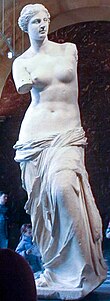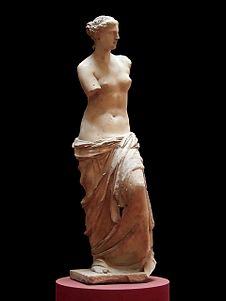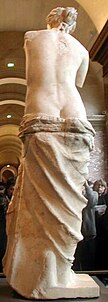Venus de Milo: Difference between revisions
Bonjovis song Queen of new orleans bears reference to venus de milo |
I tried to add a video file of the statue filmed by myself at the Louvre Museum. |
||
| Line 1: | Line 1: | ||
{{italic title}} |
https://commons.wikimedia.org/wiki/File:Venus_de_milo.ogv{{italic title}} |
||
{{Use dmy dates|date=September 2012}} |
{{Use dmy dates|date=September 2012}} |
||
{{distinguish2|the group of prehistoric statuettes known as [[Venus figurines]]}} |
{{distinguish2|the group of prehistoric statuettes known as [[Venus figurines]]}} |
||
Revision as of 08:40, 12 August 2013
https://commons.wikimedia.org/wiki/File:Venus_de_milo.ogv Template:Distinguish2
| Venus de Milo | |
|---|---|
 | |
| Artist | Alexandros of Antioch |
| Year | Between 130 and 100 BC |
| Type | Marble |
| Location | Louvre Museum, Paris, France |
| Part of a series on |
| Ancient Greek religion |
|---|
 |
Aphrodite of Milos (Greek: Ἀφροδίτη τῆς Μήλου, Aphroditē tēs Mēlou), better known as the Venus de Milo, is an ancient Greek statue and one of the most famous works of ancient Greek sculpture. Created sometime between 130 and 100 BC, it is believed to depict Aphrodite, the Greek goddess of love and beauty (Venus to the Romans). It is a marble sculpture, slightly larger than life size at 203 cm (6 ft 8 in) high. The arms and original plinth were lost following its discovery. From an inscription that was on its plinth, it is thought to be the work of Alexandros of Antioch; earlier, it was mistakenly attributed to the master sculptor Praxiteles. It is currently on permanent display at the Louvre Museum in Paris.
Description
Although the Aphrodite of Milos is widely renowned for the mystery of her missing arms[1] enough evidence remains to prove that the right arm of the statue was lowered across the torso with the right hand resting on her raised left knee so it would seem to hold the sliding drapery wrapped around the hips and legs in place.[citation needed] There is a filled hole below her right breast that originally contained a metal tenon that would have supported the separately carved right arm.
Discovery and history
The Aphrodite of Milos was discovered on 8 April 1820 by a peasant named Yorgos Kentrotas, inside a buried niche within the ancient city ruins of Milos, the current village of Tripiti, on the island of Milos (also Melos, or Milo) in the Aegean, which was then a part of the Ottoman Empire.[2] The statue was found in two large pieces (the upper torso and the lower draped legs) along with several herms (pillars topped with heads), fragments of the upper left arm and left hand holding an apple, and an inscribed plinth. Olivier Voutier, a French naval officer, was exploring the island. With the help of the young farmer, Voutier began to dig around what were clearly ancient ruins. Within a few hours Voutier had uncovered Venus de Milo. About ten days later, another French naval officer, Jules Dumont d'Urville, recognized its significance and arranged for a purchase by the French ambassador to Turkey, Charles-François de Riffardeau, marquis, later duc de Rivière.
Twelve days out of Toulon the ship was anchored off the island of Melos. Ashore, d'Urville and [fellow officer] Matterer met a Greek farmer named Moraitis, who a few days earlier while ploughing his fields had uncovered blocks of marble and a statue in two pieces, which he offered cheaply to the two young men. The marble base where the Venus de Milo originally stood still resides today on the property of his great, great nephew, Dimitri Moraitis. The Venus de Milo is a statue of a naked woman with an apple in her raised left hand, the right hand holding a draped sash falling from hips to feet, both hands damaged and separated from the body. Even with a broken nose, the face was beautiful. D'Urville the classicist recognized the Venus of the Judgement of Paris. It was, of course, the Venus de Milo. He was eager to acquire it, but his practical captain, apparently uninterested in antiquities, said there was nowhere to store it on the ship, so the transaction lapsed. The tenacious d'Urville on arrival at Constantinople showed the sketches he had made to the French ambassador, the Marquis de Rivière, who sent his secretary in a French Navy vessel to buy it for France. Before he could take delivery, French sailors had to fight Greek brigands for possession. In the mêlée the statue was roughly dragged across rocks to the ship, breaking off both arms, and the sailors refused to go back to search for them.[3]
This story however proved to be a fabrication – Voutier's drawings of the statue when it was first discovered show that its arms were already missing (Curtis, 2003).

News of the discovery took longer than normal to get to the French ambassador. The peasant grew tired of waiting for payment and was pressured into selling it to Nicholas Mourousi, Grand Dragoman of the Fleet, working as a translator for Sultan Mahmud II in Constantinople (present day Istanbul, Turkey).
The French ambassador's representative, Vicomte de Marcellus, arrived just as the statue was being loaded aboard a ship bound for Constantinople and seized the statue and persuaded the island's chief citizens to annul the sale.
Upon learning of the reversal of the sale, Nicholas Mourousi presumably had the chiefs whipped and fined. In 1821, Mourousi was executed by order of Sultan Mahmud II in front of the arsenal in Constantinople. This was amidst massive executions of Phanariote Greeks and the beginning of the Greek War of Independence.[4]
Upon arrival at the Louvre, the statue was reassembled, but the fragments of the left hand and arm were dismissed initially as being a later restoration because of the rougher workmanship.[citation needed] It now is accepted that the left hand holding the apple and the left arm are in fact original to the statue, but were not so well finished as the rest of the statue since they would have been somewhat above visible level and difficult to see.[citation needed] This was a standard practice for many sculptors of the era—less visible parts of statues often were not so well finished since typically, they would be invisible to the casual observer.[citation needed] Sculptures and statues from this era normally were carved out of several blocks of stone and carefully pieced together.[citation needed] The Venus de Milo was found to have been carved from at least six or seven blocks of Parian marble: one block for the nude torso, another block for the draped legs, another block apiece for each arm, another small block for the left foot, another block for the inscribed plinth, and finally, the separately carved herm that stood beside the statue.
Initially, the plinth was found to fit perfectly as part of the statue, but after its inscription was translated and dated, the embarrassed experts who had publicized the statue as a possible original work by the artist Praxiteles dismissed the plinth as a later addition. The inscription read: "...(Alex)andros son of Menides, citizen of Antioch on the Maeander made this (statue)...". The inscribed plinth would have moved the dating of the statue from the Classical period to the Hellenistic period because of the style of lettering and the mention of the ancient city of Antioch on the Maeander, which did not exist in the early fourth century BC, when Praxiteles lived. At that time the Hellenistic Age was considered a period of decline for Greek art. The quality workmanship in the carving would not have fit into the incorrect assessment of Hellenistic art and the plinth mysteriously disappeared shortly before the statue was presented to King Louis XVIII in 1821 and evidence of it only survives in two drawings and an early description. The king eventually presented the statue to the Louvre museum in Paris.
In 1920, sculptor Robert Ingersoll Aitken created a stir when he criticized the display, lighting, and placement of the statue of Venus de Milo in the museum.[5]
In the autumn of 1939, the Venus was packed for removal from the Louvre in anticipation of the outbreak of war. Scenery trucks from the Comédie-Française transported the masterpieces of the Louvre to safer locations in the countryside.[6] During the years of World War II, the statue was sheltered safely in the Château de Valençay along with the Winged Victory of Samothrace and Michelangelo's Slaves.[7]
Fame
The great fame of the Aphrodite of Milos during the nineteenth century was not simply the result of its admitted beauty, but also owed much to a major propaganda effort by the French authorities. In 1815, France had returned the Medici Venus to the Italians after it had been looted from Italy by Napoleon Bonaparte. The Medici Venus, regarded as one of the finest Classical sculptures in existence, caused the French to promote the Venus de Milo as a greater treasure than that which they recently had lost. The de Milo statue was praised dutifully by many artists and critics as the epitome of graceful female beauty, however, Pierre-Auguste Renoir was among its detractors, labeling it a "big gendarme".
Contemporary use
The statue used to be on the seal of the American Society of Plastic Surgeons (ASPS), one of the oldest associations of plastic surgeons in the world.[8]
In February 2010, the German magazine, Focus, featured a doctored image of this Venus giving Europe the middle finger, which resulted in a defamation lawsuit against the journalists and the publication.[9] They were found not guilty by the Greek court.[10]
An alternative explanation for the loss of her arms is given in the film Carry on Cleo.
The untranslatable[citation needed] (into English) joke 'Ceux de Milo sont venus' appears in the French version of Asterix at the Olympic Games.
A plot to steal the statue figures at the center of the 1966 spoof spy film The Last of the Secret Agents.
It can be seen in the Disney Film "Hercules", in which Hercules accidentally breaks off her arms while skipping a rock.
On the 1977 album Marquee Moon by Television, the song Venus describes a man falling into the "arms" of his "Venus de Milo."
Bon Jovi's song "Queen of New Orleans" also refers to Venus de Milo
In an episode of "The Simpsons" entitled, "Homer Bad Man", Homer steals a gummy candy in the shape of the statue.
See also
Notes
- ^ G. Davidson, Disarmed: The Story of the Venus de Milo (New York: Alfred A. Knopf) 2003.
- ^ "Venus de Milo (sculpture)". Britannica.com Inc. Encyclopædia Britannica. Retrieved 6 April 2011.
- ^ S.-C. Dumont D'Urville Two Voyages to the South Seas, Memoirs of Captain Jules. Introduction by Helen Rosenmann.
- ^ See Philip Mansel's "Constantinople: City of World's Desire, 1453–1924" (New York: Saint Martin's Press, 1996) p. 243
- ^ "Critisises museum sculpture settings; Robert Aitken says famous venus de Milo in the Louvre is worst placed of all. Stirs federation of arts academician hits at the Metropolitan among home museums and dwells on poor lighting" (pdf). New York Times. 21 May 1920. Retrieved 30 January 2011.
- ^ Nicholas 1994, p. 55
- ^ Nicholas 1994, p. 87
- ^ Journals.lww.com
- ^ "Greece Pursues Venus Defamation Case", Diehn, Sonya Angelica Courthouse News Service. 1 December 2011
- ^ "Greek Court acquits Focus journalists", burda-news.de, 3 April 2012
References
- Curtis, Gregory. (2003). Disarmed: The Story of the Venus de Milo. New York: Alfred A. Knopf. 10-ISBN 0-375-41523-8/13-ISBN 978-0-375-41523-4; OCLC 51937203
- Nicholas, Lynn H. (1995) [1994]. The Rape of Europa: The Fate of Europe's Treasures in the Third Reich and the Second World War. New York City: Vintage Books. ISBN 978-0-679-40069-1. OCLC 32531154.
{{cite book}}: Unknown parameter|month=ignored (help)



